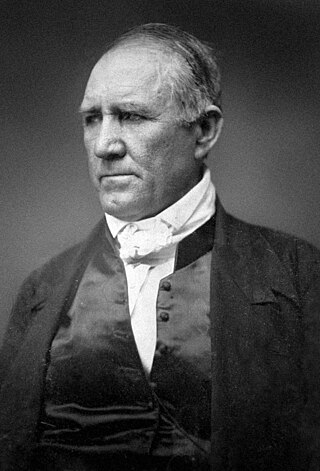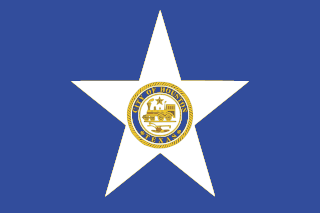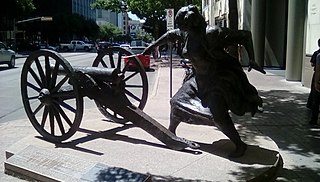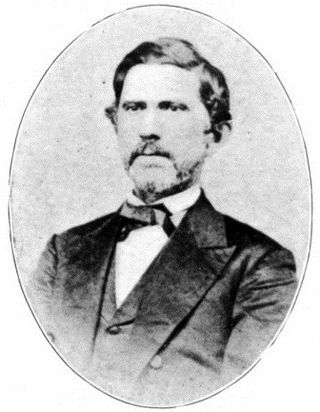
Samuel Houston was an American general and statesman who played an important role in the Texas Revolution. He served as the first and third president of the Republic of Texas and was one of the first two individuals to represent Texas in the United States Senate. He also served as the sixth governor of Tennessee and the seventh governor of Texas, the only individual to be elected governor of two different states in the United States.

The city of Houston in the U.S. state of Texas was founded in 1837 after Augustus and John Allen had acquired land to establish a new town at the junction of Buffalo and White Oak bayous in 1836. Houston served as the temporary capital of the Republic of Texas. Meanwhile, the town developed as a regional transportation and commercial hub. Houston was part of an independent nation until 1846 when the United States formally annexed Texas. Railroad development began in the late 1850s but ceased during the American Civil War. Houston served the Confederacy as a regional military logistics center. The population increased during the war and blockade runners used the town as a center for their operations.

George Smith Houston was an American Democratic politician who was the 24th Governor of Alabama from 1874 to 1878. He was also a congressman and senator for Alabama.
Francis W. Moore Jr. (1808–1864) became the second mayor of Houston, Texas, in 1838. He was elected twice more and served as mayor of the city in three consecutive decades, the 1830s, 1840s, and 1850s. He was the co-publisher of the Telegraph and Texas Register, a newspaper in Houston.

The Comanche Wars were a series of armed conflicts fought between Comanche peoples and Spanish, Mexican, and American militaries and civilians in the United States and Mexico from as early as 1706 until at least the mid-1870s. The Comanche were the Native American inhabitants of a large area known as Comancheria, which stretched across much of the southern Great Plains from Colorado and Kansas in the north through Oklahoma, Texas, and eastern New Mexico and into the Mexican state of Chihuahua in the south. For more than 150 years, the Comanche were the dominant native tribe in the region, known as “the Lords of the Southern Plains”, though they also shared parts of Comancheria with the Wichita, Kiowa, and Kiowa Apache and, after 1840, the southern Cheyenne and Arapaho.

The Texas Archive War was an 1842 dispute over an attempted move of the Republic of Texas national archives from Austin to Houston and, more broadly, over President Sam Houston's efforts to re-establish Houston as the capital of Texas.
A plantation house is the main house of a plantation, often a substantial farmhouse, which often serves as a symbol for the plantation as a whole. Plantation houses in the Southern United States and in other areas are known as quite grand and expensive architectural works today, though most were more utilitarian, working farmhouses.

John Pendleton King was an attorney, planter, and politician, serving as United States Senator from Georgia. He resigned in 1837 before the end of his term to devote himself to his plantation and business, serving for nearly 40 years as president of the Georgia Railroad and Banking Company, and becoming a cotton manufacturer. He acquired large plantation holdings, and by 1860 owned 69 slaves to work the cotton fields and related trades.

Humphrey Marshall was an American lawyer, politician, and military official from Kentucky. During the Antebellum era, he served four terms in the United States House of Representatives, interrupted by a brief stint as ambassador to China. When the American Civil War broke out, he sided with the Confederacy, becoming a brigadier general in the CS Army and then a Confederate Congressman.

Texas declared its secession from the Union on February 1, 1861, and joined the Confederate States on March 2, 1861, after it had replaced its governor, Sam Houston, who had refused to take an oath of allegiance to the Confederacy. As with those of other states, the Declaration of Secession was not recognized by the US government at Washington, DC. Some Texan military units fought in the Civil War east of the Mississippi River, but Texas was more useful for supplying soldiers and horses for the Confederate Army. Texas' supply role lasted until mid-1863, when Union gunboats started to control the Mississippi River, which prevented large transfers of men, horses, or cattle. Some cotton was sold in Mexico, but most of the crop became useless because of the Union's naval blockade of Galveston, Houston, and other ports.

The history of slavery in Texas began slowly at first during the first few phases in Texas' history. Texas was a colonial territory, then part of Mexico, later Republic in 1836, and U.S. state in 1845. The use of slavery expanded in the mid-nineteenth century as White American settlers, primarily from the Southeastern United States, crossed the Sabine River and brought enslaved people with them. Slavery was present in Spanish America and Mexico prior to the arrival of American settlers, but it was not highly developed, and the Spanish did not rely on it for labor during their years in Spanish Texas.

The following outline is provided as an overview of and topical guide to Texas:

Alexander Watkins Terrell was an American lawyer, judge, planter, Confederate officer, and diplomat. He served as the U. S. Envoy to the Ottoman Empire and a Confederate military officer. He helped pass influential legislation including the Terrell Election Law, served as president of the Texas State Historical Association and on the board of regents for the University of Texas.

John Ricord was a lawyer and world traveler. He was involved in cases in Texas, Oregon, Hawaii, and California.
Parker Hardin French was a nineteenth-century adventurer, entrepreneur, and swindler, labeled and chronicled by author Joe Goodbody as the “Kentucky Barracuda.” In the era of steam, sail and horse, the rapidity of French's movement and breadth of his adventures is almost mind-numbing. As a runaway child he fought in the Royal Navy in the First Opium War as a cabin boy and a "powder monkey". When he was just 22 years old, he was a commission merchant and, a year later, built the first ocean going ship on the upper Mississippi. Before he was 30, he was the leader of an infamous and fraudulent gold rush expedition; implicated in an irregular invasion of Cuba; jailed bandit and then military hero in Mexico; lawyer, district attorney, legislator, journalist, and political enforcer in California; senior conspirator in William Walker's conquest of Nicaragua; and appointed but rejected Nicaraguan ambassador to the United States. He didn't slow down in his thirties: he was a real estate developer; lawyer; journalist; part of a conspiracy to invade Mexico; suspected seditionist agitator and Confederate agent; jailed as a political prisoner; and lawyer and purveyor for Union troops. His final days were spent in obscurity but the period was still peppered with the occasional swindle that garnered both regional and national attention. When Colonel Parker Hardin French died in 1878, his death went generally unnoticed. Newspapers had reported the death of French before—at least five separate times. He had been twice killed in gunfights, twice executed in Mexico—once by a firing squad, once by hanging—and once killed in Nicaragua. Acquaintances thought he might have drunk himself to death. For a while, there was a lapse of interesting press reports, so many just presumed that he was already dead and were surprised when he was not. Some pondered his many misadventures and wondered how he escaped retribution from a hangman, a firing squad, or an irate victim. Though a notorious scoundrel in his time, notably from 1850 to 1862, French has been relegated to a minor footnote in antebellum America and Civil War history. The crafty Parker Hardin French contributed more to mid-nineteenth century history than has been previously documented.

William J. Hutchins was a businessman and a Mayor of Houston.
Alexander Calvit (1784–1836) was an early settler in colonial Texas and a sugar planter. His Evergreen Plantation lay where the town of Clute, Texas, was later built.

The Republic of Texas presidential election of 1838 was the second presidential election. It was held on September 3, 1838. By a provision of the constitution, the term of office of the first president was limited to two years, without his being eligible for re-election; succeeding presidents were to hold their office for three years.
Pamelia Dickinson Mann was a pioneer and hotel operator.
Sam Houston Jr. (1843–1894) was the oldest of eight children born to Sam Houston and Margaret Lea Houston, and was the only Houston child born in the Republic of Texas, before its December 29, 1845 annexation to the United States. He was home-schooled by his mother, and later attended both Bastrop Military Institute and Baylor University. After Texas seceded from the Union in 1861, he enlisted in the Confederate States Army 2nd Texas Infantry Regiment, Company C Bayland Guards. Wounded at the April 1862 Battle of Shiloh, he served time as a prisoner of war at Camp Douglas in Illinois. Following his release, he received a medical discharge from the Confederate States Army. He attended the Philadelphia University of Medicine and Surgery. Upon graduation, he returned to a private life, and it is unknown if he ever practiced medicine. At some point, he became a writer. Houston married Lucy Anderson in 1875. Their daughter Margaret Bell Houston (1877–1966) was also a writer, as well as a suffragist who became the first president of the Dallas Equal Suffrage Association. Upon his death, Sam Jr. was buried on private property near his mother.














